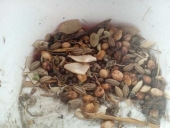Junkpole Saga #2
Ducks can fit through surprisingly small spaces and so can deer. I chased a deer strait into a supposedly impenetrable fortress after spending many hours on a certain length of fence and, to my chagrin, it hopped right through a 3ftX2ft space four feet off the ground. Impressed and enraged, I added more poles to the gap. Strange how I project my own inability to squeeze through a passage on animals with completely different sizes and abilities. In the end the fence is there to strongly dissuade the deer from entering and the ducks from exiting but I am humbled at their leisurely pace sauntering through my massive undertakings.
Apart from excluding and containing, which to my tastes are not necessarily the best motivation for building fence. There's a lot of other uses for a border!
I'm appreciating the edge created by fencing more and more as I plant out vines and hedges that will grow to encompass most of the border. Junkpoles, especially with twigs attached, make excellent trellises and birds seem to enjoy perching on the very tips of the the vertical poles. Horizontal poles are thoroughfares for chipmunks and squirrels as well. I've panted cottonwoods, willow and aspen cuttings along some of the fence so that later on I can weave it together, pollard it, and use the withes. The fence has also helped define the space of the whole plot and I often use it as a big tape measure and point of reference when I'm planting since the berms are a bit on the irregular side. They also create little micro climates where the wind is buffered, the dark poles heat up and shade is cast during different parts of the day. So there's a lot of function stacking with a fence.
Saga #2 fence iterations
I used two in ground posts fastened at the top with a screw and then filled the bottom 3-4ft with horizontal poles to keep the ducks in. Stacking the poles like a log cabin is probably the most inefficient way to make a tall animal proof fence using junkpole yet contrived. Looking back, this fence seemed like the most work to build because of the stacked poles. I did get to experiment with Swedish fence tie techniques though! I was originally inspired by this video posted in the junkpole thread:
Youtube.
I used thin, freshly cut douglas fir saplings about 3-4ft tall. Evan diligently heated them over a camp fire while I tied them since they firm up after they cool down. The key to tying them seems to be in twisting while you make a figure eight between the two posts. I found that saplings cut in late winter before the sap started to flow were better than spring cut because after the spring cut are heated the bark just falls right off after you twist. The ties have held up better than screws by far. None of them have fallen down over the past year despite my only going off a whim and a video in a different language. Evan even stood on top of a debris shelter covered in debris all resting on my first attempts at this awesome craft. So I'd say they were a success.
(50-60 poles/20ft) (2-3 screws) I now think that the screws in this design and past fences could be replaced by wooden dowels.
The next fence design was fastener-less, woven and debris bottomed to replace a portion of the first design that didn't cut it. This is one of my favorites thus far and I've been thinking of other fences along these lines. It's just two short posts banged into the ground and debris stuffed in between up to about waist height (or above the jumping distance of a lazy duck) with a woven lattice of thinner poles stuck on top. I was somehow able to weave aged poles but I think I could get the spaces even smaller with green poles.
(15-20 poles/20ft + 2wheelbarrow loads of fresh limbs) (0 Screws or other fasteners)











